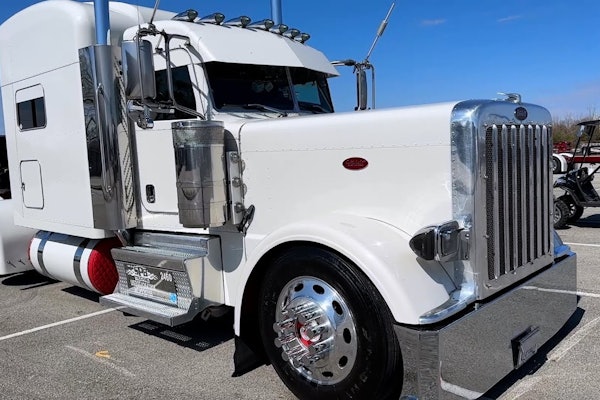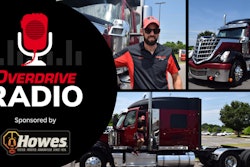Cummins ISX 450 reaches peak horsepower at 2,000 rpm.
Sometimes new technology and the changes it spurs take a while to be accepted by the people who are affected by them. Cooled exhaust gas recirculation is a perfect example.
Many veteran truckers have been wondering whether these lower-emissions engines are up to par with pre-EGR power plants. Drivers worry about power, fuel economy and overall dependability. Pete Huber, former long-haul hand who now drives locally for Schneider in western Pennsylvania, admits his first thoughts about the EGR engines were negative. “The more moving parts, the more problems and the harder it is to fix,” he says.
The regulations that spawned the new engines went into effect on Oct. 1, and more emissions reductions are slated for 2007. So this isn’t the last time you’ll have to adjust to lower-emissions power units.
Drivers will have very little in the way of technique to learn to make the EGR engines perform to their advantage. Having driven the four EPA-certified engines (Cummins, Detroit Diesel, Mack and Volvo) in a variety of terrains, I know they are drivers’ engines. Forget having to compensate for power losses with longer runs at a grade or chugging into traffic to merge after a pit stop.

The key to performance in the new iron is the turbo. All the engine makers using EGR, except for Volvo, have gone to high performance turbos that turn extremely fast and are extremely quiet. Volvo has designed its EGR engine without changing the turbo, although the new system exhibits the same lack of turbo sound as other EGR engines.
So driving EGRs can take a little getting used when there is so little turbo noise compared to what you are used to. What turbo noise there is can fool you. It’s often unconnected to throttle pressure because the turbo is reacting to messages from the engine’s computer, both in response to the EGR system’s needs for exhaust recirculation and because the computer is sensing what the driver’s immediate needs will be. But you can hear a faint rush of air behind the spooling of the turbo as it gulps air in response to throttle pressure.
All the new engines seem much quieter in other respects as well. Part of the reason is because the fan comes on less often and when it does it’s also quieter. Even when I was pulling Fancy Gap out of North Carolina with Volvo’s 435-horsepower D12D and 3:73 rears, the fan was barely noticeable.
Nor is there any noticeable lack of power in these engines. On a 7 percent grade on I-77 out of the Piedmont Plateau you, like me, might have to grab sixth gear pulling 70,000 pounds or so with an EGR engine. If you know that grade, you can appreciate how well the engine performed.
Volvo’s VE D12 465 uses V-Pulse technology to supply plenty of power on steep grades.
The Volvo’s throttle response is quicker than pre-EGR engines. The engine itself performed for me without a hiccup and exhibited strong low-end torque. Torque comes on around 1,100 rpm and stays flat to the top of the shift range. If you shift at 1,500 to save fuel, you will also save it at the other end by letting the engine lug at 1,100 rather than grabbing another gear at the low end. You might notice a slight improvement in shifting over your old engine given the improved throttle response, particularly going down through the gears. There is no hesitation getting fuel to create rpm so that timing is a little easier.
Drivers will appreciate Volvo’s attention to detail when they open the hood. The dipstick has been moved to the cool side of the engine, away from the EGR cooler, to avoid the possibility of getting burned.
Mack has developed two versions of EGR. The on-highway version works a little differently than the I-EGR, which was developed for the vocational market.
Steve Ginter, Mack’s marketing vocational manager, says Mack’s OTR version of cooled EGR is designed for applications where speed and load are constant. The CH 427, like all of the modern engines, has a great deal of torque throughout the rpm range, but it comes on a little more quickly than most, thanks to what is called variable geometry turbo. This, when coupled with quicker throttle response, makes the Mack engine, like other EGR solutions, a strong performer not only when power is needed but in other situations where low-end torque and response make driving easier. Corners where you might have wanted to find a gear with pre-EGR engines can be pulled through more easily and merging into traffic at the get-ons can require fewer shifts.
Detroit’s Series 60 variable nozzle turbo supplies the most aggressive throttle response of the four EGR engines. The new style turbo gives enough quick throttle response to make the time-honored technique of getting a run for the next upgrade a more effective maneuver. The obvious reason for this performance is the variable speed turbos most OEMs have incorporated into the EGR process.
“Variable speed turbos have been around a long time,” according to Phil Rimnac, manager of the Series 60 Advanced Product program, “but price was prohibitive. EGR made it necessary to use the power of the variable turbo.” Judging by the performance of the engine brakes on EGR engines, the new turbos necessary to run the system have also given engine brakes more power. Forcing the correct amount of exhaust back into the charge air cooler requires the ability to both vary the speed of the turbo and to create more flow pressure to shoot inert gases into the cylinders. It is by creating more back pressure that the turbos have revved up engine brake performance.
One advantage shared by all these engines is that a blown turbo is much less likely to be sucked down into the block. The EGR cooler and other hardware will catch broken turbo fan blades long before they wind up scouring liners and pistons.
Detroit Diesel’s Series 60 offers a variable nozzle turbocharger that supplies an impressive throttle response.
Under the hood, Detroit’s EGR technology is obvious. The cool pipe from the cooler comes across the top near the front and connects with the charge air feed headed for the block. This pipe requires a word of caution. Its position may tempt some drivers to use it as a handhold while climbing with the hood open to wash the windshield. Despite its name, this pipe is not cool. Using it as a handhold will get you burned.
Like the other new engines, Cummins has plenty of throttle response, probably more than all but the Detroit. You can start at the bottom of a decent grade loaded heavy and grab gears easily. Or you can let it sit at 1,150 rpm and conserve fuel. If you do get into it, the response is gratifying. Torque rises to about 1,450 and levels off there, letting the horsepower come on. The Cummins 450, for example, achieves peak horsepower at 2,000 rpm.
Fleet drivers looking for fuel bonuses and owner-operators wanting increased mileage, would do well to use the low-end torque of modern engines to counteract some of the fuel lost to clean burn. Most OEMs anticipate a slight drop – anywhere from a 2 percent to 5 percent – in miles per gallon with EGR compared to the newest engines. Owner-operator Terry White said he traded in his truck for a new truck with a pre-EGR engine before the Oct. 1 deadline. “One reason I traded was to avoid using more fuel. I just heard too much talk about increased costs.” He was surprised to hear the new engines did not exhibit power loss and performed well.
Some drivers, like Keith Holt, an independent owner-operator who is partial to Caterpillar engines, are wanting to see that company’s answer to the new emissions regulations. Caterpillar is going a different route than the other engine makers with its development of ACERT technology. “I run a 600 Cat and don’t want to think about more fuel,” Holt says. “I’m waiting to see what Cat comes up with.”
As expected, under-hood temperatures are generally higher in the new power plants, but less than 20 degrees. Engine cooling packages have been beefed up, but there is no more maintenance required. Even so, drivers will want to keep their radiators topped off. Service intervals vary, but you will want to know what interval your truck requires in order to make sure it gets done. On-time service intervals are extremely important for all of the new EGR engines. You will also want to make sure you add the proper oil when necessary. New oils have been developed, designated CI-4, to handle the increased amount of soot and acids produced by EGR engines.
Drivers need to be aware of fault codes. Most of the new engines have half a dozen more codes that might show up as idiot lights than you might be used to. And you can be reassured about air conditioning and the in-cab environment. Under-hood temps and the need for increased cooling have done nothing to make your air conditioner work harder or throw more heat into the cab on hot days. And cabs are also quieter across the board, not only because of decreased turbo noise but because truck makers have designed more sound dampening and insulation into cab construction for their newest trucks.
Driving these engines will make believers out of sceptics. If you are lucky enough to find yourself climbing behind the wheel and looking out over an EGR engine’s hood, your experience should quickly dispel the negative myths surrounding the new technology.










